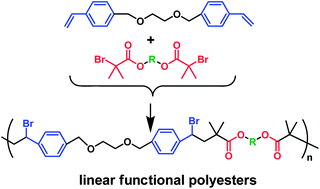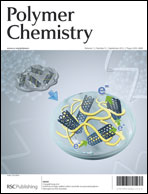We report on the facile synthesis of a range of new linear functionalized polyesters by controlled atom transfer radical polyaddition reactions. One bis-styrenic type monomer, 1,2-bis(4-vinylbenzyloxy)ethane (AA), and two bis-methacrylate type ATRP initiators, 1,2-bis(2-bromoisobutyryloxy)ethane (BB) and bis[2-(2-bromoisobutyryloxy)ethyl]disulfide (BssB), were synthesized. The polymerizations of monomer AA with BB and BssB were carried out in anisole at 0 °C, using Cu/CuBr2 coupled with N,N-bis(2-pyridylmethyl)octylamine (BPMOA) as the catalyst. The polymerization kinetics were investigated and the polymers were characterized by GPC and NMR, both confirming the step-wise mechanism with the formation of the expected linear polyesters having pendent bromides. When BssB was used, additional disulfide groups were incorporated in the polyester main chain, imparting a tunable degradation mechanism to the polyester. Moreover, the pendent bromides on the polymers could serve as initiation sites or precursors to azides to prepare biodegradable graft copolymers. This has been proven by two examples, reactivating the pendent bromides at room temperature to initiate the ATRP of other methacrylates, and transforming these groups into azido-groups by substitution reaction followed by click chemistry with alkynyl-terminated polyethylene glycol.

You have access to this article
 Please wait while we load your content...
Something went wrong. Try again?
Please wait while we load your content...
Something went wrong. Try again?


 Please wait while we load your content...
Please wait while we load your content...